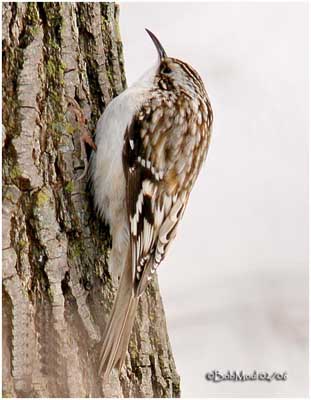
Brown Creeper
Certhia americana
Passeriforme Order – Certhiidae Family
BIOMETRICS:
Lenght : 12 à 14 cm
Wingspan : 17 à 20 cm
Weight : 5 à 10 g
LONGEVITY: Up to 4 years
DESCRIPTION:
Brown Creeper has streaked brown plumage, providing very good camouflage. Its mottled feathers make it indistinguishable when on the bark.

Upperparts are dark brown, heavily streaked with white on head, back, shoulders and wings. Rump is reddish-brown. Wings show a buff wing bar, conspicuous in flight.
Underparts are white with reddish-brown mixed in.
Long, stiff tail is reddish-brown and used as a prop.
Head has dark brown forehead, crown and nape, with white streaks. Chin, cheeks and throat are white. Brown Creeper has long down-curved dark bill, with lower paler mandible at the base of the bill. Eyes are dark brown with white eyebrow. Legs and feet are brown. Legs are short and slender. Toes are slender with long, sharp claws.
Male and female look similar, but male is slightly larger with longer bill.
Juvenile resembles adults with light spotting on underparts. Upperparts are duller.
VOICE: SOUNDS BY XENO-CANTO
Brown Creeper’s call is a soft and sibilant “see”. Song is a musical phrase of several notes “see-wee-see-titi-see…”. Sounds are high pitched, and may vary within populations. The Creeper’s song is considered as one of the gems of bird music.
HABITAT:
Brown Creeper breeds in coniferous or mixed forests. It needs large trees, dead or alive, for nesting and foraging.
RANGE:
Brown Creeper lives throughout North America, from Canada and Alaska to Newfoundland, and southwards to northern Nicaragua.
Brown Creeper is resident in most of its range, but northern populations migrate southwards in winter, except in high mountains regions.
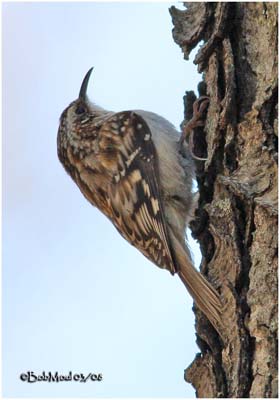
BEHAVIOUR:
Brown Creeper forages along tree trunks and main branches on trees, rarely on the ground. The bird starts at the base of the tree, following a spiral course upwards, and encircling the trunk several times on its way to the top. Once the bird is high up in the tree, it flies down to the base of another tree and repeats its ascension.
In order to climb easily, it uses its stiff-pointed tail feathers as a support against the trunk. It probes and picks insects out of bark-crevices, with its long curved bill.
Brown Creeper is a solitary arboreal bird outside the breeding season, but sometimes, it may join foraging flocks of song birds. During winter, communal roosting has been observed. Brown Creeper is an active bird, usually seen creeping up tree trunks and foraging for food.
During breeding season, male performs some displays to attract females. Male performs a high-speed flight display among the trees, making circles around the trunks and weaving in and out of branches, and pursuing a potential mate.
Brown Creepers are monogamous. Male uses songs to attract a mate. Then, male and female chase one another, with rapid fluttering and displaying their white underparts. During nesting period, before hatching of chicks, male performs “courtship feeding” to female. Pair remains together several weeks after fledging.
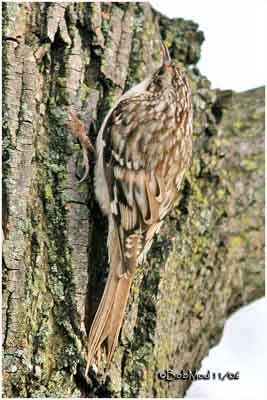
When alarmed, Brown Creeper uses its camouflage pattern. It lands on tree trunk, flattened, with spread wings, and remains motionless. Mimicry with bark is unbelievable!
FLIGHT:
Brown Creeper performs a strong direct flight of short duration.
REPRODUCTION:
Brown Creeper breeds from mid-May to mid-June. Brown Creeper’s nest-site is chosen by both adults, but female builds the nest, at about 5 to 15 feet above the ground. Male may bring some nest materials to her. Nest is often located between the trunk and a loose piece of bark on a dead tree, or in natural cavity. Female needs one to four weeks to build it. Nest is made with twigs, mosses, conifer needles and silk from spider webs. Twigs and bark form a crescent-shaped base. On the top of foundation, there is a cup of bits of bark, grasses and mosses. Interior is lined with bits of bark and feathers.
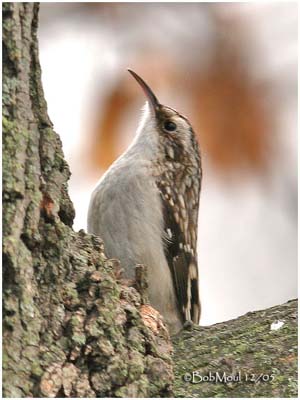
Female lays 3 to 7 white or creamy eggs, finely marked with small brown dots. Incubation lasts about 13 to 17 days, and starts when the last egg is laid. Female incubates alone, but male feeds her during this period.
Altricial chicks are brooded by female when weather is bad, and they are fed by both parents. Adults clean the nest, carrying away from the nest shells and fecal sacs. Young fledge at about 15 to 17 days after hatching. They are able to climb immediately to the bark with their strong claws. At this time, young don’t have the long stiff tail feathers of the adults.
Parents feed them for at least 15 days more. Young gather in groups and roost together to conserve warmth. They reach their sexual maturity at about one year.
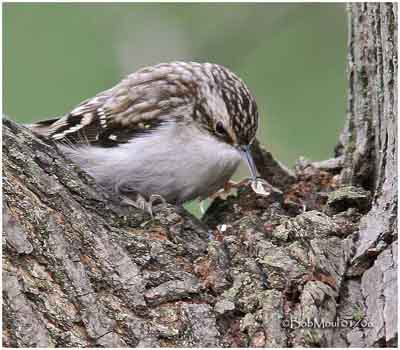
DIET:
Brown Creeper feeds mainly on spiders, larvae and insects. They may also consume nuts, seeds and some vegetable matters during winter.
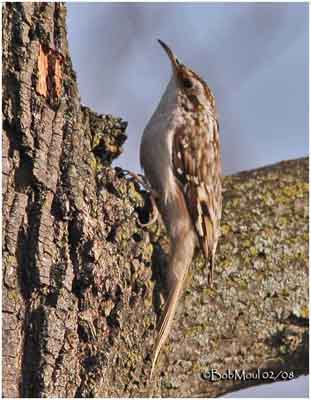
PROTECTION/THREATS/ STATUS:
Brown Creeper’s eggs are preyed upon by Red Squirrels and birds by cats and small mammals.
Brown Creeper’s populations are listed as endangered or threatened in several states. They are threatened by habitat loss and degradation of their breeding range, and disappearance of large wooded areas.
Fr: Grimpereau brun
All : Andenbaumläufer
Esp : Trepador Americano
Ital : Rampichino americano
Nd : Amerikaanse Boomkruiper
Sd : Amerikansk trädkrypare
Photographs by Bob Moul
His website : Nature Photography
Text by Nicole Bouglouan
Sources :
FIELD GUIDE TO THE BIRDS OF NORTH AMERICA by National Geographic Society - National Geographic Society - ISBN: 0792274512
All About Birds (Cornell Lab of Ornithology)
Animal Diversity Web (University of Michigan Museum of Zoology)
Bird Web (Seattle Audubon Society)
What Bird-The ultimate Bird Guide (Mitchell Waite)
Wikipedia (Wikipedia, The Free Encyclopedia)
Birds of Nova Scotia (Robie Tufts)